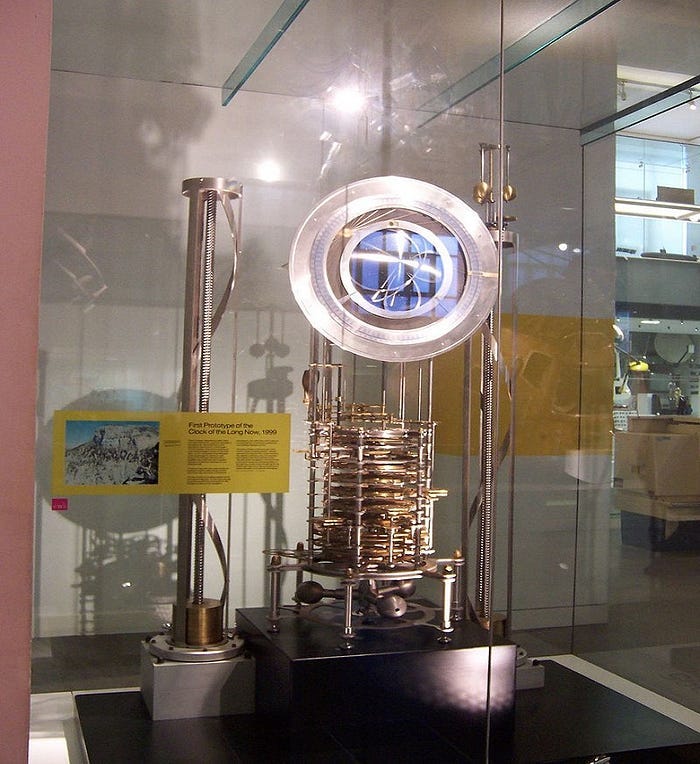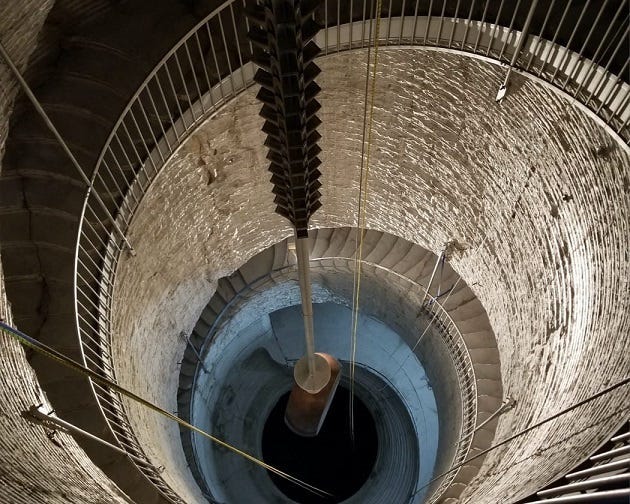Modern Humanity’s Monument Designed To Last 10,000 Years
A clock that changes our perception of time and long-term thinking

“I sense that I am alive at a time of important change, and I feel a responsibility to make sure that the change comes out well. I plant my acorns knowing that I will never live to harvest the oaks.”
What’s a long time? It’s a difficult and varied question for the average person nowadays. For some, standing in a line for five minutes is a long time. Others might say a year. Many see a presidential term of four years in this light. Regardless, most have difficulty looking past their own lifetime.
We tend to think on short timescales. It’s hard not to with our cheaply mass-produced tools and clothing, designed to fall apart and be replaced. Also, our musical choices and fashion, which regularly change.
It’s only speeding up as technology changes the world around us so quickly: from Walkman, to Discman, to iPod, to streaming service. All within shorter time frames.
But history reframes this idea of time.
The Great Pyramid of Giza is 4,500 years old. It was built so long ago, the ancient Egyptians had a different North Star than we do today. But this is nothing. Hunter-gatherers are thought to have built the stone monument Gobekli Tepe about 12,000 years ago.
Similarly, former Disney engineer and the creator of parallel processing, Dany Hillis found another example at Oxford University in England. In his essay quoted above, he says:
“I think of the oak beams in the ceiling of College Hall at New College, Oxford. Last century, when the beams needed replacing, carpenters used oak trees that had been planted in 1386 when the dining hall was first built. The 14th-century builder had planted the trees in anticipation of the time, hundreds of years in the future, when the beams would need replacing.”
These examples from history demonstrate a concept of long-term thinking which is totally alien to us today. It’s the anthesis to our modern disposable world. But Hillis wants to rekindle it.
He and a group called The Long Now Foundation are creating history today in the form of a clock, called the Clock of the Long Now. It’s designed to last 10,000 years. The device’s purpose — in both creation and presence — is to develop the long-term thinking our throw-away society has lost.
How Do You Build A Clock That Lasts 10,000 Years?
“When you start thinking about building something that lasts that long, the real problem is not decay and corrosion, or even the power source. The real problem is people. If something becomes unimportant to people, it gets scrapped for parts; if it becomes important, it turns into a symbol and must eventually be destroyed. The only way to survive over the long run is to be made of materials large and worthless, like Stonehenge and the Pyramids, or to become lost.”
The Long Now Foundation believes you need more than just technology to create a device that can last this long. You need principals to guide it. So, they created a set of five to drive the entire project:
Longevity: The clock must keep the correct time, go slow, have minimum friction of parts, keep dry and clean, account for bad weather, expect human interaction, and deter theft
Maintainability: The clock must function with little maintenance, be able to be repaired with bronze age tech
Transparency: The clock must be able to be examined, so its function can be inspected and understood
Evolvability: The clock must be capable of being improved
Scalability: Working models should be able to be scaled to massive sized monuments

The organization, created in 1996, had a working prototype by 1999, which chimed in the millennium. By 2018, with a forty-two million dollar investment from Jeff Bezos, a scalable five-hundred foot tall version was being created.
The foundation also figured out a way to adhere to many of the principals they set out in the beginning — build the clock inside a mountain.
The Technology Of The Clock
The clock uses the mountain where it’s housed as a type of protective shell. It maintains a temperature of about 55 degrees Fahrenheit year-round, plus protects it from weather. Also, making it less visible hides it from two-legged destructive forces.
Its components are made of “titanium, ceramics, quartz, sapphire, and 316 stainless steel.” The clock itself is mechanical, storing power from the sun and the hands of human visitors who activate sections of the clock by turning wheels.
Sun enters the mountain through a window made of sapphire. The rays heat a chamber of air that moves a graphite cylinder, creating enough winding force to move a titanium pendulum slowly. It also synchs the system to solar noon.
A series of dials, and calendars are present in a room, which visitors can see, after passing and visibly inspecting the massive gears, pendulums, and weights of the clock. While the clock always keeps the time, the display only shows it when a human visitor generates mechanical energy by turning a wheel.
The clock has a mechanical chime generator made of Geneva wheels, which ring bells in a unique and non-repeating series. These will chime when a visitor creates the power.
The main winding mechanism is made of an enormous series of gears, which can store energy from the sun or human hands within a giant weight hanging from the “rack gear.” Its design allows it to run for years without solar or muscle power driving it.
Many of these gears are larger than a person, and the drive weight powering the clock itself weighs 10,000 lbs. You’ll see this after climbing a massive concrete spiral staircase. The largeness of the device creates an awe-inspiring experience. In essence, it’s what The Long Now Foundation wants.
An Experience To Alter The Way People Think
“The Clock is hundreds of feet tall, engineered to require minimal maintenance, and powered by mechanical energy harvested from sunlight as well as the people that visit it. We hope one of them will be you.”
— The Long Now Foundation Website
The mountain where the clock is located is hours away from the nearest airport. In fact, away from everything. To visit it, you’ll be required to hike in. To turn some of the gears to power the clock’s displays, you’ll need a team of people.
So, the clock requires a group pilgrimage of sorts to visit it. In many ways, it’s like a trip to the Pyramids in Egypt or Gobekli Tepe in Turkey, but this monument isn’t an artifact from the past. It’s an artifact from the now to remind us of thinking from the past.
The ancient buildings I mentioned were designed to last beyond the civilizations that created them. We need that thinking again. Specifically if our kind plans to travel to different worlds, disposable creations won’t get us there. Things can’t be replaced that quickly so far from home.
Long-term thinking is required. The type of planning that grew a forest in recognition beams would be needed in the future for buildings in Oxford. Hopefully, an experience like the clock can inspire minds to think thoughts like these again in our present throw-away world.
While the clock is still being built, its creators have made a lot of progress, and members of The Long Now Foundation will be among the first invited to visit it. They just require you pony up the sizeable fee of $8 a month to join the foundation.
Compared to what the pharaoh taxed his people to fund the pyramid, it’s a relative bargain.
-Originally posted on Medium 6/5/22


